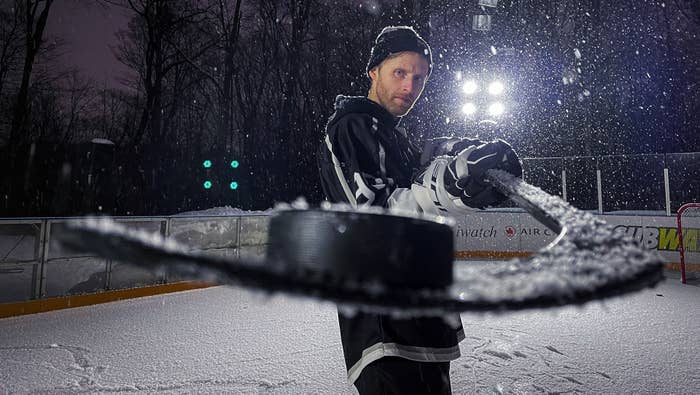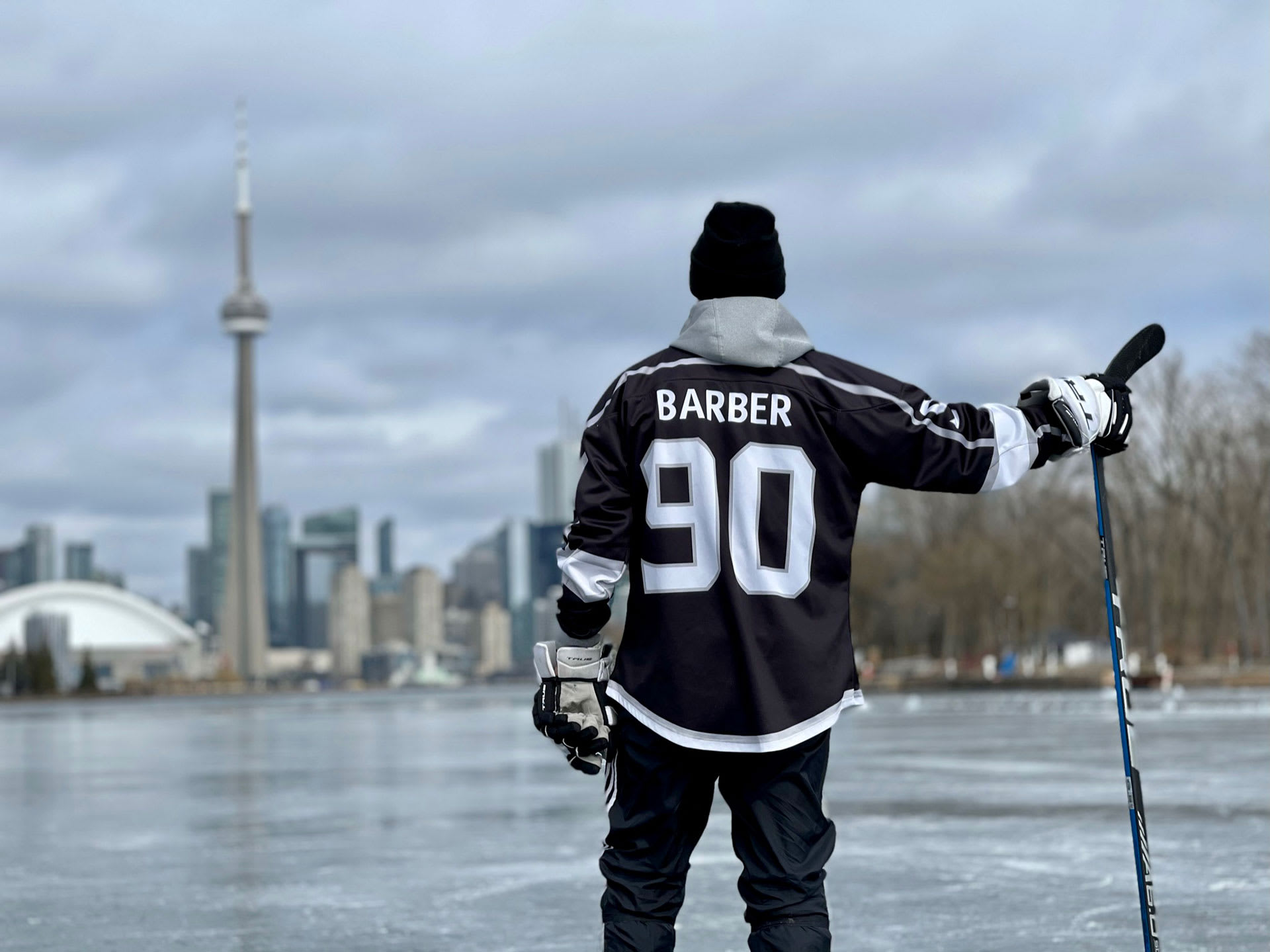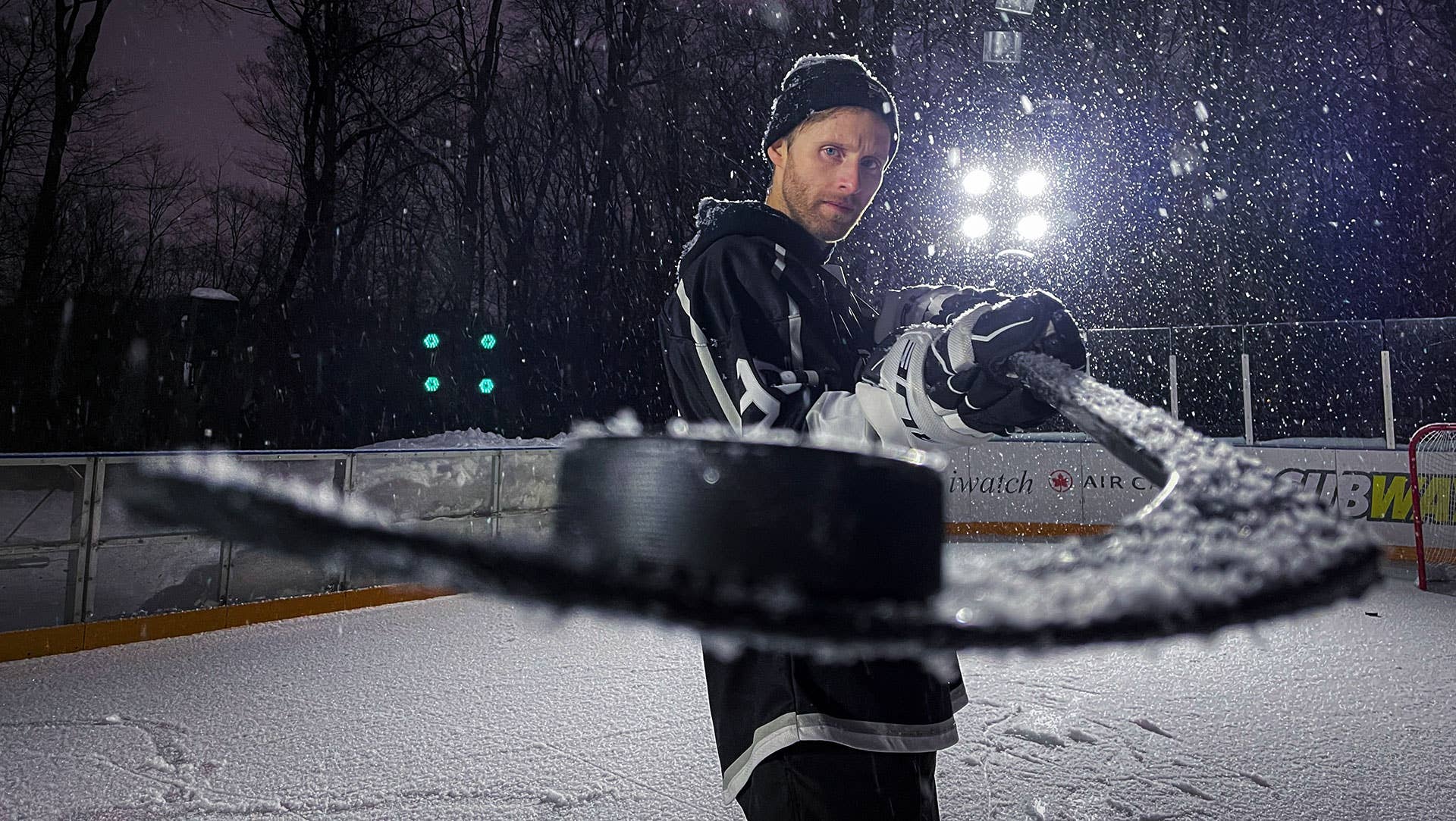
Pavel Barber knows how to wield a hockey stick. The Toronto-based hockey instructor, stickhandling specialist, and social media influencer has become something of an ice-friendly superstar on Instagram, TikTok, and YouTube, making a name for himself with his jaw-dropping hockey tricks and stick moves. He’s had the knack for it from a young age, but these days he’s entered the big leagues, training children in honing the craft and even working with NHL players looking to fine-tune their game.
Barber recently got himself set up on a private rink in North York, just outside of the city center, that is the definition of #RinkGoals—one of the most professional looking private rinks you can imagine outside of a full-blown hockey arena. We caught up with Barber to get some insight into his stick-handling skills, how to shoot skating and hockey moves like a pro on the iPhone, and how he became a social media celeb.
I saw recently that you were skating out on Lake Ontario. How the hell do you get out there and do that?
That was fun. What we do is we take the Jack Layton ferry over to Ward’s Island and then we walk basically 15 minutes west. We go to an island called Snake Island and it’s just right there. It’s crazy and it’s super easy to get to. We always go with local guys there who know the ice a bit better than we do, just to be safe.
I’m in my early 30s, and if you wanted to learn how to do stuff growing up, you had to basically teach yourself. How did you learn these skills?
We weren’t too wealthy growing up so we didn’t have money for private lessons or anything like that. I’m in my early 30s too. We didn’t have many resources. I lived five minutes away from an outdoor rink, so I would go there and train myself. I would watch my favourite players and try to mimic what they did on the ice. My first favourite player was Paul Kariya on the Ducks, and then I became obsessed with Pavel Datsyuk. I’d bring video with me to the rink, and film myself trying things, and trying to compare it. It was an obsession with breaking things down and doing it myself.
So what did that breaking down look like?
I’d watch the footage over and over. With hockey it’s crazy—there’s the edge work involved to do the skill, and then there’s the stick handling, and you need to have both components. You have to go skating first, stick handling second, and you have to time the skating with the stick handling and make sure you do everything right. It’s completely overwhelming when you’re new to it.
How old were you when you learned to skate?
I was four. Like all Canadians, right?

At what point did you realize you were gifted at this?
That’s always a tough question. I would say probably around 14 or 15 for me—I started to notice my skills with the puck would separate myself from the others. At 8 years old I was good at it, but it’s easier then to see those gaps. It started to get more fun, once I was in full control and could keep my head up more, around that age.
How important are these technical details to actually being able to play well at a professional level?
I think the higher level you get, the more these technical details mean. When I’m training an eight- to 10-year-old kid, we’re trying to build the basics of the forehand movement, the backhand movement, the basic levels of control. We have to really secure that foundation and then build on that. But when you’re training an NHL player, those little details—being able to decrease puck spin, being able to load it to the toe quicker—mean more, because at their level, things happen quicker. It’s important to remember that what works when you’re eight years old won’t work when they’re like nine or 10 and people learn to backwards skate and stuff.
You’ve built a big social media following based on these technical skills that are very visually impressive and showy. Are there skills that you’ve developed that are only visual—that you wouldn’t want to teach an NHL player?
Yeah, oh 100 percent. A large portion of what I do on social media is to just be entertaining. It’s to take hockey and extend what we can do with a stick and a puck. Most of the moves that go viral are not moves you would do in a game. They’re quite useless. It’s fun to do them—and a lot of NHL players can do them. But they’re never anything I teach in any of my camps. To get the views, to drive engagement, to get people interested, you have to step outside the box and do something new.
I interviewed Raptors coach Nick Nurse recently, and he said that a lot of times, in the NBA, there are top-level players who don’t actually have a great grasp on some really fundamental techniques. Is that true in the NHL too?
I would definitely agree with Nick Nurse on that. In the hockey world there are guys out there that don’t have a grasp on the fundamentals. The biggest thing is top hand rotation—making sure you’re moving the blade the right amount to keep the puck flat and to pull it in different directions. I always look at the top 10 guys when I’m analyzing hockey, and you can see that their top hand rotation is flawless. They barely come over the puck; they move their hands quick. It’s faster because they’re very efficient. Some guys have never practiced it or were never taught it. That’s one simple thing that gets overlooked.
Are there things about hockey techniques now that has changed over time? Do we think about hockey differently now?
Big time. Stick handling specifically—people used to think that if you stick handle in the middle of the blade, that’s the best thing to do, because if you mess up, you have more space on the blade. In reality, most of it is at the heel, and that’s changed a lot. I remember Wayne Gretzky, on an instructional video, telling you to do it in the middle. You never want to say, “Hey Wayne, you’re not doing it right,” but yeah. And at the time, that was great information. That was the best information available. But the game has evolved and so too has our thinking.
What’s the biggest misconception people have about the game?
The biggest misconception is that, if the player looks down at the ice with their eyes that they can’t see anything. That’s the biggest thing people say. In hockey, we have contact. Because we have contact, people say if you look down, you’ll get crushed. We joke about it all the time. The difference is, if your head is completely down, I can’t see anything and it limits my vision. But you’re able to see quite a bit ahead of you, and everyone’s afraid to tell kids that it’s OK to peek down.
You’ve been shooting a lot of video on the iPhone. What attracted you to the iPhone as a photographer, and what’s it been like?
My first experience with it was probably a year ago to this day. We were up at Lake Louise just testing it out and seeing what we could do with the iPhone. I was just blown away by the quality of it. The feature that crushes it for me is that stabilization. We shot something and I literally thought it was shot on a gimbal but it was actually shot on my phone. It’s unbelievable. We’ve just got some absolutely cool shots when we use the iPhone. It’s been a game-changer me.
I tried shooting on the ice recently—it’s very hard to skate and shoot at the same time. Do you have any tips for doing it well?
That’s the thing—with skating it’s like learning to walk again. If you have difficulty skating you’re going to have arm movement. Keep your arms quiet. You think you need your upper body to move but you don’t. You just need to move your legs. If you want to get a movement shot, get into your stable stance, and get a friend to give you a little boost push. It looks funny but the shot you get is amazing. You can try to build up your speed, get into position, and then stay in a glide while shooting. But the main thing is keeping the arms quiet.

